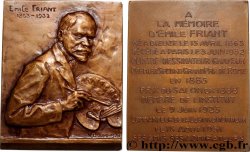fme_551532 - III REPUBLIC Médaille commémorative de la bataille de Verdun
Not available.
Item sold on our e-shop (2020)
Price : 30.00 €
Item sold on our e-shop (2020)
Price : 30.00 €
Type : Médaille commémorative de la bataille de Verdun
Date: 1916
Mint name / Town : 55 - Verdun
Metal : bronze
Diameter : 29,5 mm
Orientation dies : 12 h.
Engraver VERNIER Émile Séraphin (1852-1927)
Weight : 12,35 g.
Edge : lisse + corne BRONZE
Puncheon : corne BRONZE
Coments on the condition:
Léger nettoyage
Obverse
Obverse legend : ON NE PASSE - PAS .
Obverse description : Allégorie de la ville avec son épée; signé : S. E. / VERNIER / 1917.
Reverse
Reverse legend : VERDUN // 21 FEVRIER / 1916.
Reverse description : Portes de la ville entre deux palmes.
Commentary
Émile Séraphin Vernier, né à Paris le 16 octobre 1852, décédé à Paris le 9 septembre 1927, est sculpteur, plaquettiste, ciseleur et graveur-médailleur français.
En août 1915, le Quartier Général français ne reconnaissant plus aucune valeur stratégique aux forts, désarme ceux autour de Verdun et supprime la garnison. L’État-major allemand profite alors de la vulnérabilité de la place, pour mener une offensive. Le 21 février 1916 vers 7 heures, deux millions d'obus s’abattent sur Verdun. Mais contrairement à ce à quoi s'attendaient les Allemands et leur commandant en chef le général Erich von Falkenhayn, l'armée française résiste et campe sur ses positions.
La bataille dure près de 10 mois, faisant 163 000 morts et 216 000 blessés du côté français et 143 000 morts et 196 000 blessés du côté allemand. À l'automne 1916, l'armée française, profitant de l'offensive de la Somme, contre-attaque, reprend les forts perdus et repousse les Allemands. Verdun est sauvée....
Émile Séraphin Vernier, born in Paris on October 16, 1852, died in Paris on September 9, 1927, was a French sculptor, plaquetist, chaser, and medal engraver. In August 1915, the French General Headquarters, no longer recognizing any strategic value in the forts, disarmed those around Verdun and removed the garrison. The German General Staff then took advantage of the vulnerability of the place to launch an offensive. On February 21, 1916, around 7 a.m., two million shells rained down on Verdun. But contrary to what the Germans and their commander-in-chief, General Erich von Falkenhayn, had expected, the French army resisted and stood firm. The battle lasted nearly 10 months, leaving 163,000 dead and 216,000 wounded on the French side and 143,000 dead and 196,000 wounded on the German side. In the autumn of 1916, the French army, taking advantage of the Somme offensive, counterattacked, recaptured the lost forts, and drove back the Germans. Verdun was saved...
En août 1915, le Quartier Général français ne reconnaissant plus aucune valeur stratégique aux forts, désarme ceux autour de Verdun et supprime la garnison. L’État-major allemand profite alors de la vulnérabilité de la place, pour mener une offensive. Le 21 février 1916 vers 7 heures, deux millions d'obus s’abattent sur Verdun. Mais contrairement à ce à quoi s'attendaient les Allemands et leur commandant en chef le général Erich von Falkenhayn, l'armée française résiste et campe sur ses positions.
La bataille dure près de 10 mois, faisant 163 000 morts et 216 000 blessés du côté français et 143 000 morts et 196 000 blessés du côté allemand. À l'automne 1916, l'armée française, profitant de l'offensive de la Somme, contre-attaque, reprend les forts perdus et repousse les Allemands. Verdun est sauvée....
Émile Séraphin Vernier, born in Paris on October 16, 1852, died in Paris on September 9, 1927, was a French sculptor, plaquetist, chaser, and medal engraver. In August 1915, the French General Headquarters, no longer recognizing any strategic value in the forts, disarmed those around Verdun and removed the garrison. The German General Staff then took advantage of the vulnerability of the place to launch an offensive. On February 21, 1916, around 7 a.m., two million shells rained down on Verdun. But contrary to what the Germans and their commander-in-chief, General Erich von Falkenhayn, had expected, the French army resisted and stood firm. The battle lasted nearly 10 months, leaving 163,000 dead and 216,000 wounded on the French side and 143,000 dead and 196,000 wounded on the German side. In the autumn of 1916, the French army, taking advantage of the Somme offensive, counterattacked, recaptured the lost forts, and drove back the Germans. Verdun was saved...








 Report a mistake
Report a mistake Print the page
Print the page Share my selection
Share my selection Ask a question
Ask a question Consign / sell
Consign / sell
 Full data
Full data













